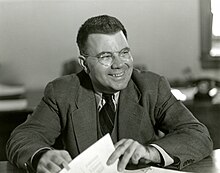Edward Condon | |
|---|---|
 Edward Condon at NIST (c. 1945-1951) | |
| Director of National Bureau of Standards | |
| In office 1945–1951 | |
| President | Harry S. Truman |
| Preceded by | Lyman James Briggs |
| Succeeded by | Allen V. Astin |
| Personal details | |
| Born | March 2, 1902 Alamogordo, New Mexico Territory, U.S. |
| Died | March 26, 1974 (aged 72) Boulder, Colorado, U.S. |
| Education | University of California, Berkeley (BS, MS, PhD) |
| Known for | Condon–Shortley phase Franck–Condon principle Slater–Condon rules Nimatron Quantum tunneling theory of alpha decay Radar and nuclear weapons research Target of McCarthyism |
| Scientific career | |
| Fields | Physics |
| Institutions | |
| Thesis | On the theory of intensity distribution in band systems (1927) |
| Doctoral advisor | Raymond Thayer Birge |
| Doctoral students | Edwin McMillan |
| Other notable students | Walter Kauzmann (postdoc) James Stark Koehler (postdoc) Richard Zare (postdoc) |
Edward Uhler Condon (March 2, 1902 – March 26, 1974) was an American nuclear physicist, a pioneer in quantum mechanics, and a participant during World War II in the development of radar and, very briefly, of nuclear weapons as part of the Manhattan Project. The Franck–Condon principle and the Slater–Condon rules are co-named after him.[1][2][3]
He was the director of the National Bureau of Standards (now NIST) from 1945 to 1951. In 1946, Condon was president of the American Physical Society, and in 1953 was president of the American Association for the Advancement of Science.
During the McCarthy period, Condon was one of the first prominent scientists to become a target of the House Un-American Activities Committee, charged publicly in 1948 with being "one of the weakest links in our atomic security" on account of his extensive knowledge of classified information, his connections with the development of the atomic bomb, and his alleged sympathies for communism and the Soviet Union. His case became a cause célèbre among those who opposed McCarthyism, especially scientists, and was one of the most prominent cases of its time, and he was defended by many prominent scientists, as well as President Harry Truman.[4]
Condon became widely known in 1968 as principal author of the Condon Report, an official review funded by the United States Air Force that concluded that unidentified flying objects (UFOs) have prosaic explanations. The lunar crater Condon is named for him.
- ^ Edward Condon Archived November 5, 2013, at the Wayback Machine was elected as a member of the US National Academy of Sciences in 1944.
- ^ "APS Fellow Archive". www.aps.org. Archived from the original on March 3, 2016. Retrieved April 22, 2018.
- ^ Branscomb, Lewis M. (June 1974). "Edward Uhler Condon". Physics Today. 27 (6): 68–70. Bibcode:1974PhT....27f..68B. doi:10.1063/1.3128661.
- ^ Wang, "Security," 238, 249, 256fn47